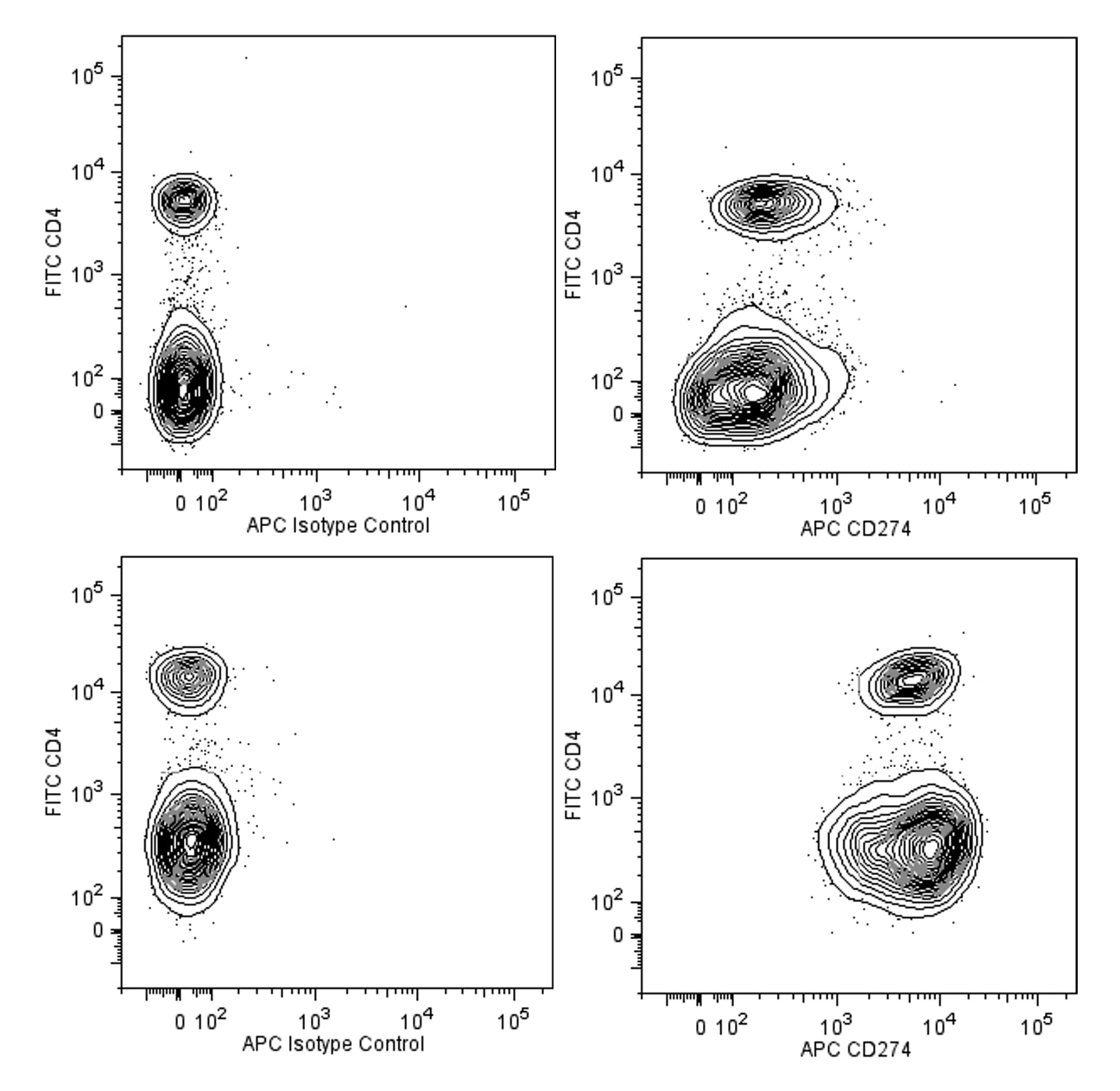Old Browser
Looks like you're visiting us from {countryName}.
Would you like to stay on the current country site or be switched to your country?


.png)

Two-color flow cytometric analysis of CD274 expression on resting and activated mouse splenocytes. Mouse splenic leucocytes were either not activated (Upper Panels) or activated (Lower Panels) by culture with plate-bound Purified NA/LE Hamster Anti-Mouse CD3 antibody (Cat. No. 553057) for 3 days (37°C). The cells were preincubated with Purified Rat Anti-Mouse CD16/CD32 antibody (Mouse BD Fc Block™) (Cat. No. 553141/553142). The cells were then stained with FITC Rat Anti-Mouse CD4 antibody (Cat. No. 553729/557307/561828) and either APC Rat IgG2a, λ Isotype Control (Cat. No. 560720; Left Panels) or APC Rat Anti-Mouse CD274 antibody (Cat. No. 564715; Right Panels). Two-color flow cytometric contour plots showing the correlated expression of CD274 (or Ig Isotype control staining) versus CD4 were derived from gated events with the forward and side light- scatter characteristics of viable leucocytes. Flow cytometric analysis was performed using a BD™ LSR II Flow Cytometer System.
.png)

BD Pharmingen™ APC Rat Anti-Mouse CD274
.png)
Regulatory Status Legend
Any use of products other than the permitted use without the express written authorization of Becton, Dickinson and Company is strictly prohibited.
Preparation And Storage
Product Notices
- Since applications vary, each investigator should titrate the reagent to obtain optimal results.
- An isotype control should be used at the same concentration as the antibody of interest.
- Caution: Sodium azide yields highly toxic hydrazoic acid under acidic conditions. Dilute azide compounds in running water before discarding to avoid accumulation of potentially explosive deposits in plumbing.
- This APC-conjugated reagent can be used in any flow cytometer equipped with a dye, HeNe, or red diode laser.
- For fluorochrome spectra and suitable instrument settings, please refer to our Multicolor Flow Cytometry web page at www.bdbiosciences.com/colors.
- Please refer to www.bdbiosciences.com/us/s/resources for technical protocols.
Companion Products





.png?imwidth=320)
The MIH5 monoclonal antibody specifically binds to CD274, also known as B7-H1 or PDL1, a 43-kDa glycoprotein encoded by the Pdcd1lg1 gene of the B7 family of the Ig superfamily. Pdcd1lg1 mRNA is expressed in more tissues than other members of the B7 family; transcripts are found in lymphoid tissues and many, but not all, non-lymphoid tissues. The protein has been detected at low levels on resting peripheral T and B lymphocytes, macrophages, and dendritic cells. B7-H1 mRNA and protein expression are upregulated upon activation of T and B cells, macrophages, dendritic cells, and epidermal keratinocytes by a variety of stimulatory factors. B7-H1's receptor, PD-1, contains an ITIM (Immunoreceptor Tyrosine-based Inhibitory Motif) on its intracytoplasmic region and is expressed on activated B and T lymphocytes, suggesting that B7-H1-PD-1 interaction may be involved in the negative regulation of immune responses. The second PD-1 ligand, B7-DC (PD-L2), is also a member of the B7 family of the Ig superfamily. Furthermore, B7-H1 may participate in positive immunoregulation, or costimulation of T cells, through an additional receptor, which is not PD-1 and distinct from the alternate receptor for B7-DC. The MIH5 antibody blocks the binding of PD-1-Ig to B7-H1 transfectants.

Development References (9)
-
Ansari MJ, Salama AD, Chitnis T, et al. The programmed death-1 (PD-1) pathway regulates autoimmune diabetes in nonobese diabetic (NOD) mice. J Exp Med. 2003 July; 198(1):63-69. (Biology). View Reference
-
Carreno BM, Collins M. The B7 family of ligands and its receptors: New pathways for costimulation and inhibition of immune responses. Annu Rev Immunol. 2002; 20:29-53. (Biology). View Reference
-
Dong H, Chen L. B7-H1 pathway and its role in the evasion of tumor immunity. J Mol Med. 2003 May; 81(5):281-287. (Biology). View Reference
-
Hessel EM, Chu M, Lizcano JO, et al. Immunostimulatory oligonucleotides block allergic airway inflammation by inhibiting Th2 cell activation and IgE-mediated cytokine induction. J Exp Med. 2005; 202(11):1563-1573. (Clone-specific: Flow cytometry). View Reference
-
Liu X, Gao JX, Wen J, et al. B7DC/PDL2 promotes tumor immunity by a PD-1-independent mechanism. J Exp Med. 2003; 197:1721-1730. (Biology). View Reference
-
Tamura H, Dong H, Zhu G, et al. B7-H1 costimulation preferentially enhances CD28-independent T-helper cell function. Blood. 2001; 97(6):1809-1816. (Biology). View Reference
-
Tsushima F, Iwai H, Otsuki N, et al. Preferential contribution of B7-H1 to programmed death-1-mediated regulation of hapten-specific allergic inflammatory responses. Eur J Immunol. 2003; 33(10):2773-2782. (Immunogen: Blocking, Functional assay, Immunofluorescence, Immunohistochemistry, Inhibition, In vivo exacerbation). View Reference
-
Wang S, Bajorath J, Flies DB, Dong H, Honjo T, Chen L. Molecular modeling and functional mapping of B7-H1 and B7-DC uncouple costimulatory function from PD-1 interaction. J Exp Med. 2003; 197:1083-1091. (Biology). View Reference
-
Yamazaki T, Akiba H, Iwai H, et al. Expression of programmed death 1 ligands by murine T cells and APC. J Immunol. 2002; 169(10):5538-5545. (Biology). View Reference
Please refer to Support Documents for Quality Certificates
Global - Refer to manufacturer's instructions for use and related User Manuals and Technical data sheets before using this products as described
Comparisons, where applicable, are made against older BD Technology, manual methods or are general performance claims. Comparisons are not made against non-BD technologies, unless otherwise noted.
For Research Use Only. Not for use in diagnostic or therapeutic procedures.
Report a Site Issue
This form is intended to help us improve our website experience. For other support, please visit our Contact Us page.